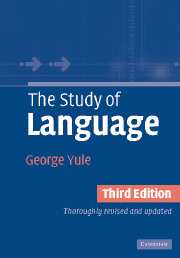Book contents
- Frontmatter
- Contents
- Preface
- The origins of language
- Animals and human language
- The development of writing
- The sounds of language
- The sound patterns of language
- Words and word-formation processes
- Morphology
- Phrases and sentences : grammar
- Syntax
- Semantics
- Pragmatics
- Discourse analysis
- Language and the brain
- First language acquisition
- Second language acquisition/learning
- Gestures and sign languages
- Language history and change
- Language and regional variation
- Language and social variation
- Language and culture
- Appendix: Suggested answers to study questions
- Glossary
- References
- Index
Language and social variation
- Frontmatter
- Contents
- Preface
- The origins of language
- Animals and human language
- The development of writing
- The sounds of language
- The sound patterns of language
- Words and word-formation processes
- Morphology
- Phrases and sentences : grammar
- Syntax
- Semantics
- Pragmatics
- Discourse analysis
- Language and the brain
- First language acquisition
- Second language acquisition/learning
- Gestures and sign languages
- Language history and change
- Language and regional variation
- Language and social variation
- Language and culture
- Appendix: Suggested answers to study questions
- Glossary
- References
- Index
Summary
Admittedly, it is hard to make stylistic judgements on slang from the past, but when we read a seventeenth-century description of someone as a “shite-a-bed scoundrel, a turdy gut, a blockish grutnol and a grouthead gnat-snapper” it's unlikely the writer was using the neutral or “proper” language of the time – I think we can safely assume he was using slang.
Burridge (2004)In the preceding chapter, we focused on variation in language use found in different geographical areas. However, not everyone in a single geographical area speaks in the same way in every situation. We recognize that certain uses of language, such as the slang in Kate Burridge's description, are more likely to be used by some individuals in society and not by others. We are also aware of the fact that people who live in the same region, but who differ in terms of education and economic status, often speak in quite different ways. Indeed, these differences may be used, implicitly or explicitly, as indications of membership in different social groups or speech communities. A speech community is a group of people who share a set of norms and expectations regarding the use of language. The study of the linguistic features that have social relevance for participants in those speech communities is called ‘sociolinguistics’.
- Type
- Chapter
- Information
- The Study of Language , pp. 205 - 215Publisher: Cambridge University PressPrint publication year: 2005



